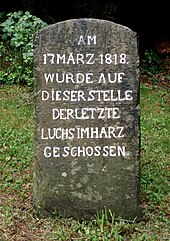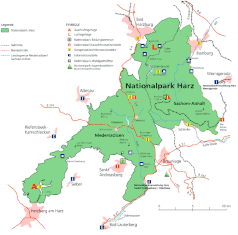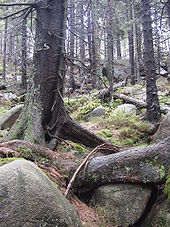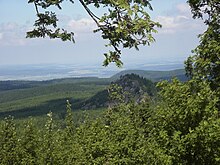Harz National Park
| Harz National Park | ||
|---|---|---|
| The Brocken seen from Torfhaus | ||
|
|
||
| Location: | Lower Saxony , Saxony-Anhalt , Germany | |
| Next city: | Wernigerode , Bad Harzburg , Herzberg , Braunlage | |
| Surface: | 247.03 km² = 24,703 ha | |
| Founding: | October 1, 1990 / January 1, 1994 (merger January 1, 2006) | |
| Address: |
Website of the National Park Administration Lindenallee 35 38855 Wernigerode |
|
| Overview map of the national park | ||
| Brockenblick | ||
The Harz National Park is one of the largest forest national parks in Germany, which was founded in 2006 through the merger of the Harz National Parks in Lower Saxony and Saxony-Anhalt. With its 247.03 km² (approx. 158 km² in Lower Saxony and 89 km² in Saxony-Anhalt ) it covers about ten percent of the total area of the Harz around the Brocken , from Herzberg in the south to Bad Harzburg and Ilsenburg in the north. The park is internationally recognized by the IUCN and part of the European Natura 2000 system of protected areas . About 96 percent of the area is covered by forests, especially spruce and beech forests. In addition to the extensive forest areas, moors occupy an outstanding position because of their special characteristics. Granite cliffs and mountain streams also shape the landscape .
Geographical location
The Harz National Park is located in the western part of the Harz (see Upper Harz ) and extends from Wernigerode and Ilsenburg in the north to Herzberg and Bad Lauterberg in the south. In its peripheral areas, the park is located at heights of 230 m in the north to 270 m in the south and rises to 1,141.2 m above sea level. NHN at the summit of the Brocken.
The headwaters of several rivers such as the Bode , the Oder or the Ilse are located in the area of the national park . Or the flow through the Oderteich and feeds the location of the south-eastern border of the park Odertalsperre . Other dams and standing waters within or on the edge of the national park include the Eckertalsperre and the Silver Pond . The highest peaks are the Brocken , the Bruchberg and the Achtermann .
history
Today's cross-border Harz National Park was created on January 1, 2006 through the merger of the Harz National Park in Lower Saxony and the Hochharz National Park in Saxony-Anhalt. Since the merger, Andreas Pusch has been the head of the large conservation area .
The Hochharz National Park was set up on October 1, 1990 two days before German reunification on the basis of a Council of Ministers resolution of the GDR government on the national park program. The park encompassed the eastern high Harz around the Brocken between Eckertalsperre , Hohnekamm and Schierke , later extended to Ilsenburg. The region is characterized by little-touched flora and fauna, which is mainly due to the so-called "Brocken Urwald " , which has not been used for forestry for centuries, and the location directly on the former German-German border. In the GDR era, the Brocken was accessible with an easy-to-obtain pass until 1961. From August 13, 1961, it became a restricted area , so it was no longer used for tourism. Since the 1970s, forest problems such as bark beetles or fungal infestation have also appeared in the Harz . In the course of the spirit of optimism at the time of reunification, they were also the ones who initiated the establishment of the national park. On January 1, 1991, the national park administration in Wernigerode began its service under the direction of Hubertus Hlawatsch. Peter Gaffert acted as Hubertus Hlawatsch's successor from 1995 until the merger with the western Harz National Park (2006).
The Lower Saxony part of the park was launched on January 1, 1994 after four years of preparation. Wolf-Eberhard Barth was the founding director . Although there has been talk of a joint national park project in both countries since the fall of the Wall, it took another twelve years to implement it.
The Harz National Park belongs to the European umbrella organization EUROPARC Federation , a network of national parks, biosphere reserves and nature parks . Among other things, he deals with the exchange of information, training, public relations and lobbying. The German section EUROPARC Deutschland e. V. of this umbrella organization has also organized the network of many large protected areas in Germany.
In 2005 the national park was included in the European Charter for Sustainable Tourism in Protected Areas.
The national park currently employs 160 people who work in the national park administration offices in Wernigerode (headquarters), the branch in Sankt Andreasberg OT Oderhaus and in the area. The employees of the national park guard, who are also known as rangers, give tours and perform tasks in public relations and environmental education, right up to the supervision of information points and national park houses.
Zoning
The Harz National Park is recognized by the IUCN as a national park (protected area of category II according to the IUCN system). According to the guidelines, at least 75 percent of the area must be designated as a natural dynamic zone (core zone). In this zone nature is completely left to its own devices. If this area share is not reached, the areas can be classified as so-called development national parks if they meet these requirements within 30 years.
The Harz National Park is considered a development national park. Currently, 60 percent of the area of the national park is designated as a natural dynamic zone. The aim is to exceed the 75 percent hurdle by 2022 .
39 percent of the national park area is currently still a nature development zone. Measures are carried out here according to the forest development concept. The aim is to transfer the largest possible parts of this natural development zone to the natural dynamic zone.
One percent of the area is considered a usage zone. These include areas that are important for tourism or cultural history, such as the Brockenkuppe, mountain meadows and heavy metal lawns or the areas of the Upper Harz water management. Maintenance measures will also take place here in the future.
Furthermore, forest protection measures are carried out within a 500 m wide zone around the national park to protect the adjacent forest areas.
Climatic conditions
There are special climatic conditions on the Brocken, which are comparable to those of Iceland . In the harsh climate of the Harz Mountains, the natural tree line is 1100 m above sea level, so the summit of the Brocken at 1141.2 m is treeless. A tundra-like heather vegetation grows between the lichen-covered rock heaps of the Harz , which is adapted to the frequent fog, the low temperatures and 300 days of rain and snow . Due to the high levels of rainfall in the mountain areas, the Harz is one of the most water-rich regions in Germany.
On foggy days, in addition to halos , the “ Brocken ghost ” can also be observed extremely rarely on the Brocken . The latter is an optical effect in which objects are projected oversized onto the fog.
ecology
flora

The natural forests of the high Harz consist mainly of Norway spruce ( Picea abies ) and mountain ash ( Sorbus aucuparia ), only below 600 m height deciduous trees dominate the forest. Since the Harz was partially deforested by ore mining in the 18th century, the Count's Chief Forester Hans Dietrich von Zanthier developed the concept of reforesting with fast-growing spruce trees. This gave rise to the spruce monoculture that is widespread today. Unlike the "resin spruce", the spruce trees planted in other regions are less able to cope with the snow and ice loads in the Harz and are therefore more susceptible to bark beetle infestation .
At the moment, 82 percent of the forests consist of spruce stands. Only 12 percent of the trees are beeches. The remaining 6 percent of the trees are species such as oak , mountain ash or birch . (As of December 2007)
In the Harz National Park there are different levels of vegetation. In the subalpine area over 1050 m is the " battle zone " of the spruce. Here the trees are often over 250 years old and bent into bizarre shapes by the wind. There are mainly various dwarf shrub heaths and raised bogs here . Between 750 m and 1050 m altitude you are in the high-montane vegetation level . The spruce dominates here. These areas can be found in the area around Schierke and Torfhaus . Beech forests predominate only in the montane area between 450 m and 750 m altitude and the submontane vegetation level. Today's beech stocks grow on predominantly acidic soil. The predominantly forest community to be found is the Hainsimsen-Buchenwald . The mixed spruce and beech forest usually follows in the areas over 700 m. But this area in the national park has shrunk to a few remnants and has been replaced by spruce trees. In the Ilsenburg region, spruce monoculture even goes down to a height of 230 m . The spruce is not native to these zones, as a result of climate change there has been increased damage from bark beetle infestation. The national park administration is currently planting there in order to reintroduce the originally dominant beech and sycamore , which are appropriate to the location here .
The Harz is home to the Brocken anemone ( Pulsatilla alpina subsp. Alba ), which in Germany only grows on the Brocken plateau. Its populations have been particularly endangered by the mass tourism that has set in since reunification, but have stabilized again. The Brockengarten , a botanical garden on the Brocken summit, focuses on the protection of species and the renaturation of the hilltop.
The raised bogs are particularly valuable for nature conservation - the renaturation of former bog areas has been initiated. The prerequisites for this are favorable, as the raised bogs in the national park are less exposed to human use than the bogs in the Lower Saxony lowlands. When the wood in the Harz became scarce, attempts were made to use the peat of the moors. This turned out to be unprofitable due to the low calorific value of the peat and the weather conditions in the Hochharz. The moors in the Harz Mountains are of international importance due to their characteristics and flora.
fauna

The European lynx lives again in the Harz Mountains today . This has been considered to be extinct in this area since the early 19th century. A last report on a successful lynx hunt in the Harz comes from 1818. In an eleven-day hunt in which almost 200 people took part, a male lynx was hunted down near Lautenthal . The so-called lynx stone still reminds of this hunting success today . The hunted specimen was prepared and exhibited in a diorama in the Natural History Museum in Braunschweig. In 1999 it was decided to reintroduce the lynx. Between 2000 and 2007, 24 lynxes were released from zoo offspring. Before they are released, the animals are prepared for freedom in a large acclimatization enclosure. In addition, there is a show enclosure at the national park forest restaurant Rabenklippe , in which the shy cats can also be observed by national park visitors. Since 2002 there have been numerous records of young animals born in the wild. Some lynx received a GPS transmitter. This way you can get more detailed information about where the animals are.
Another reintroduction project was the capercaillie , which died out in the Harz between 1920 and 1930. The release into the wild began in 1978. Over time, around 1000 animals were raised and released into the wild. Despite the animals still present, the population is assessed as unsafe. The project was discontinued in 2003 due to a lack of prospects of success.
The wildcat has one of its most important German occurrences in the Harz Mountains today. It is classified as endangered in the Federal Republic of Germany. It can be assumed that the wildcat has a stable population in the Harz Mountains. It is widespread in the entire area and prefers the warmer, more structured and better-supplied locations with nutrients (deeper deciduous forest regions with greater food supply).
In addition to the lynx and wildcat, there are also a. Red deer and roe deer are important animal species in the Harz National Park.
The raccoon or occasionally the raccoon dog appear as neozoa . The European mouflon , which was settled in various areas of the Harz for hunting reasons in the 1930s, is also found in the national park.
Ecological problems
In addition to acid rain and other ecological problems , the Harz National Park has recently also had difficulties with the mass reproduction of bark beetles. The bark beetles are also on the rise here due to global warming . Since 2006 there have been increased bark beetle gradations. Hurricane Kyrill also caused severe damage in the region in 2007 . Trees, especially spruce, collapsed over long stretches. The management of the national park in neighboring communities came under criticism due to the subsequent necessary bark beetle control measures. The Ilsenburg national park community in particular criticized the use of technology (e.g. harvesters ). Due to the inaccessibility of the area, however, it was hardly possible to get the trunks knocked over by the wind from the affected areas.
In the so-called natural development zone of the Harz National Park, which surrounds the core zone, the bark beetle is fought where necessary and plantings are also carried out locally to promote natural forest development. To protect these beech and oak plantations, wildlife management appropriate to the national park is also required. Allegations that there had been private or state hunts in the national park turned out to be baseless.
tourism
The national park is an important tourist factor in the Harz Mountains. The Brocken , which was inaccessible for a long time, is the main attraction of the large reserve. Every year around 1 million visitors are counted there. A number of visitors of around 4 million can be estimated for the entire national park. More precise figures have not been recorded. The national park region with its neighboring cities and communities has around nine million visitors annually.
Attractions

The region offers many sights. The main destination of most visitors is the Brocken. Here you have the opportunity to actively experience the history of the Brocken in the former “Stasi Mosque”, today's Brockenhaus . The park offers extensive exhibitions on various topics in its national park houses. For example, in Sankt Andreasberg mining and geology or in the House of Nature in Bad Harzburg specifically on the forest habitat.
In addition, the natural features are particularly worth seeing. In addition to the Brocken, the Wolfswarte at Torfhaus or the Hohnekamm with the Leistenklippen are very popular with visitors . Popular hikes are, in addition to the Brocken tour, the tours around Lonau, the Oderteich or along the Rehberger Graben in the western part of the park. In the eastern part, many visitors go on hikes to the Hohnekamm or through the Ilsetal to the Eckertalsperre . You can even bathe in the southern part of the Oderteich and in the silver pond .
View from the Leistenklippe on the Grenzklippe and Brocken
Transport links
The national park can be visited all year round. Its area is well developed in terms of traffic. From the north it can be reached via the federal autobahn 36 and A 369 as well as the federal highways 6 and 4 . From the south, the park can be reached via the federal highway 38 (Südharzautobahn) and the federal highways 242 and 27 . In Drei Annen Hohne , Schierke and Torfhaus there are large parking spaces that are suitable as starting points for various hiking routes. The National Park can also be reached with the Brocken Railway . The train stations Drei Annen Hohne, Schierke and Brocken are located directly at or in the national park, they are good starting points for exploring. You can get to the park by train via the Wernigerode , Bad Harzburg , Ilsenburg and Herzberg am Harz stops .
Information facilities
The national park administration maintains five national park houses. These are located in Altenau - Torfhaus , Drei Annen Hohne , Ilsenburg , Sankt Andreasberg ( Samsoner Erzwäsch ) and Schierke . Other national park facilities are the Brockenhaus and the House of Nature in Bad Harzburg .
National Park Communities
The following cities and communities are located within the Harz National Park or in its immediate vicinity (in alphabetical order): Altenau , Braunlage , Bad Harzburg , the Herzberg districts of Lonau and Sieber , Ilsenburg , the Osterode district of Riefensbeek-Kamschlacken and the Wernigerode district of Schierke .
literature
- Literature from and about Harz National Park in the catalog of the German National Library
- Hans-Jürgen Beug, Irmtraud Henrion, Anneke Schmüser: Landscape history in the high Harz. The development of forests and moors since the end of the last ice age . 1st edition. Paper plane, Clausthal-Zellerfeld 1999, ISBN 3-89720-256-5 , p. 1–454 + 1 card ( abstract and table of contents ).
- Meike Hullen: Harz National Park: two federal states - one protected area . 4th edition. Lower Saxony Ministry of the Environment, Hanover 2007.
- Uwe Wegener: High Harz National Park with Brocken, Saxony-Anhalt . Schadach, Goslar 1991, ISBN 3-928728-00-8 .
- Hochharz (= values of the German homeland . Volume 73). 1st edition. Böhlau, Cologne / Weimar / Vienna 2014, ISBN 978-3-412-20467-9 .
Filmography
- Germany's wild animals - In the Harz and Hochharz national parks , documentary, 45 min., Germany, 1998, by Ina Knobloch and Manfred Praxl
- The Harz - Dark Forest and Light Heights , documentary, 45 min., NDR, Germany 2005, by Uwe Anders
Web links
- Official website of the national park administration
- National park map including maps for the Harz National Park 2011 - 2020, in the valid version from 2011 (PDF file; 15.67 MB), accessed on November 26, 2014
- Species report of the national park (status 2004) for the Lower Saxony part (PDF file; 458 kB)
- The National Park Association
- TorfHaus National Park Visitor Center
- Official website of the lynx project
References and comments
- ↑ a b c d e f g About us - Profile with brief information about the Harz National Park , on nationalpark-harz.de
- ↑ Legal basis of the Harz National Park | The National Park | Harz National Park. Retrieved on July 21, 2019 (German).
- ↑ a b IUCN = International Union for Conservation of Nature and Natural Resources ("international union for the preservation of nature and natural resources")
- ↑ Saxony-Anhalt viewer of the State Office for Surveying and Geoinformation ( notes )
- ↑ EUROPARC Germany: Association Philosophy , accessed on March 31, 2008
- ↑ regional structure , on nationalpark-harz.de
- ↑ a b Forest development in the Harz National Park , on nationalpark-harz.de
- ↑ Information from the National Park Administration , Department 2, Research and Science , in March 2008
- ↑ The forests of the national park , on nationalpark-harz.de
- ↑ Cf. Gunter Karste (2006): The Brocken Garden in the Harz National Park . In: Sachsen-Anhalt 16 (2006), no. 4, pp. 2-4. ISSN 0940-7960
- ↑ See Sabine Bernsdorf, Nadine Böhlmann, Ralph Meissner, Wolfgang Merbach (2003): Moor research in the Harz Mountains; Development and protection of the moors in the Hochharz National Park . In: Scientia Halensis 11 (2003), no. 4, pp. 21-22, pdf . ISSN 0945-9529
- ↑ … Moore ( Memento of the original from June 17, 2009 in the Internet Archive ) Info: The archive link was inserted automatically and has not yet been checked. Please check the original and archive link according to the instructions and then remove this notice. , on nationalpark-harz.de
- ^ Jürgen Hevers: Braunschweiger Dioramas , State Natural History Museum, Braunschweig 2003
- ↑ Lynx project Harz monitoring results
- ↑ Cf. Ralf Siano (2006): Survival time, causes of death and use of space of bred capercaillie (Tetrao urogallus L.), released in the Harz National Park . In: Vogelwarte 44 (2006), no. 3, pp. 145-158 ISSN 0049-6650
- ↑ The Bark Beetle - A Neverending Story , on sachsen-anhalt.nabu.de
- ↑ No "GDR state hunt under the Brocken" ... , press release from the Harz National Park, on lifepr.de
- ^ Information from the National Park Administration , Department 4, Public Relations , in March 2008
- ↑ Uwe Anders: The Harz - Dark forest and clear heights. Expeditions into the animal kingdom. Norddeutscher Rundfunk, December 26, 2005, archived from the original on January 6, 2010 ; accessed on November 30, 2015 .














